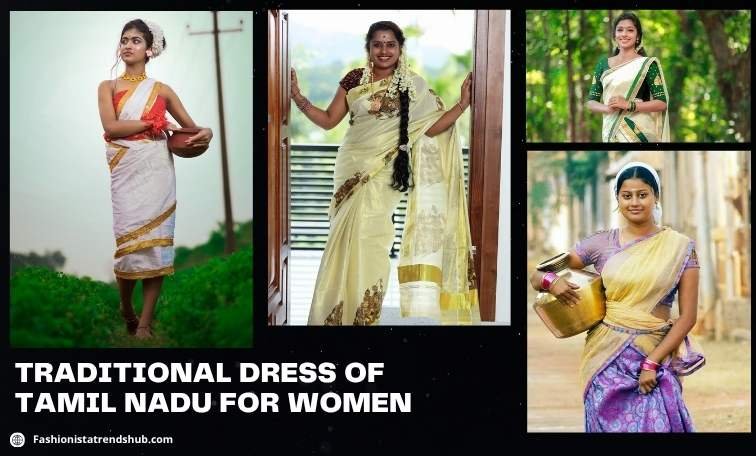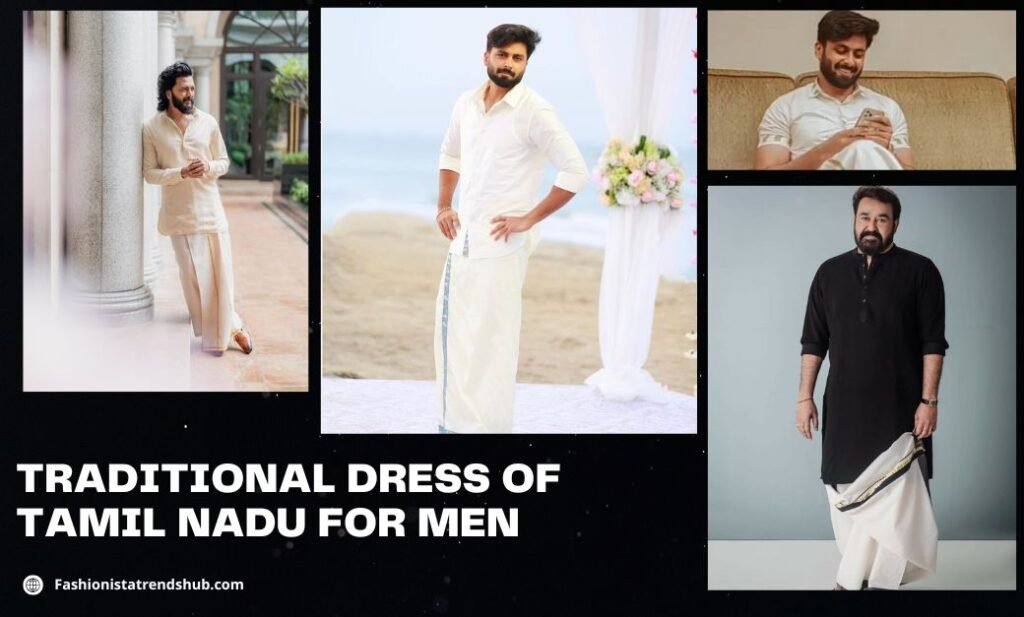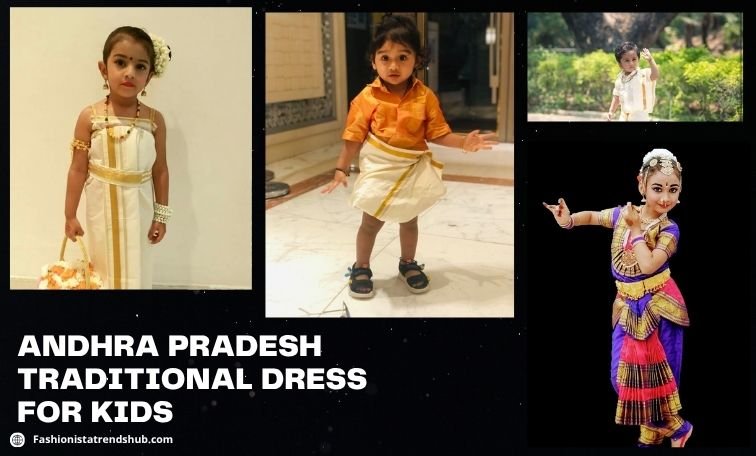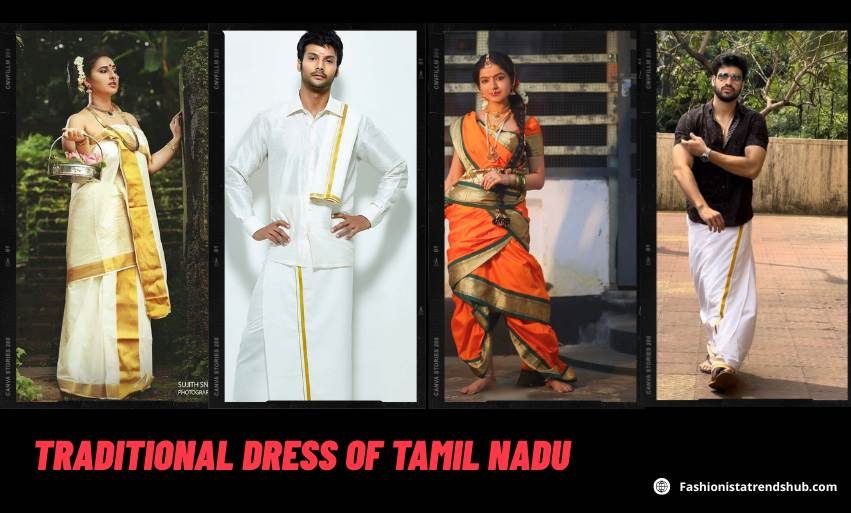Tamil Nadu’s vibrant textile heritage can be experienced through its mesmerizing traditional dresses. The traditional dress of Tamil Nadu is a beautiful blend of distinct styles, drapes, and fabrics that represent the region, religion, gender, community, as well as occasion.
In this article, we will talk in detail about the intricacies behind ethnic costumes like sarees, veshtis, and pavadais etc. We will cover their origin, types, styles, standout features, and much more. Hope you enjoy our comprehensive article on Tamil Nadu’s traditional dresses.
What is the Traditional Dress of Tamil Nadu?
The traditional dress of Tamil Nadu is predominantly unstitched and symbolically draped. The core garments are:
- Saree (Also known as Sari) for women- a yard-long piece of material worn as a skirt and draped over the body to cover it.
- Veshti / Dhoti / Mundu for Men- A Long Cloth draped around the waist.
- Pavadai‑davani / Half saree for young girls- This costume is worn by young girls of South India
- Angavastram (shawl) or upparikai as an accessory
The regular clothing of people in Tamil Nadu is traditional, embedded with culture, and not to be overshadowed. In fact, traditional Tamil literature, such as Silappadhikaram, talks about women in fine garments and of men in appearance nothing more than a cloth wrap around the loins.
More than just drapes for the body, they also indicate identity, status, community, and aesthetics.
History & Significance of Traditional Dress of Tamil Nadu
The traditional dress of Tamil Nadu is believed to have existed for thousands of years. Ancient Tamil literature and sculpture indicate that draped garments were carried by dancers in religious plays. Weaving traditions of playing with pattern and texture are part of the Tamil tradition, which has asserted itself over a long history. Over time, symbolic meanings gathered:
- Religious sanctity: Some drapes (like the Madisar) are dedicated to temple rituals.
- Social Signals: The colors and patterns of the border could signify caste, region or even marital status.
- Cultural Continuity: Handloom has been passed down over generations, protecting tradition.
- Regional Specialties: Koorai Pattu Saree (a Type of silk and cotton mix) is the traditional gifting choice of people in Koranad, Mayiladuthurai.
It’s these layers of meaning that have prevented traditional dress from being reduced to mere rags—it is wearable heritage to date for a reason.
Traditional Dress of Tamil Nadu Women

The traditional dress of Tamil Nadu for women is varied, graceful, and expressive. The choices depend on age, occasion, and community.
Key styles worn by women
| Garment | Description | Occasion & Notes |
| Kanchipuram (Kanjeevaram) Saree | Handwoven silk with rich zari borders and motifs | Preferred for weddings, festivals, heirloom quality |
| Madisar / Madisār | A 9‑yard saree draped in a special style | Worn by Tamil Brahmin married women for rituals and auspicious functions |
| Chettinad cotton saree | Lightweight cotton with bold checks or stripes | Every day wear, temple visits, summer days |
| Pavadai‑Davani (Half saree) | A three‑piece set: skirt (pavadai), blouse, drape (davani) | Favoured by adolescent girls during festivals |
| Salwar Kameez / Churidar / Kurti | Stitched garment combining a tunic and pants | Adopted widely, especially in urban or daily settings |
Styling, Drape, and Flair
- Temple dons, peacock and floral designs, the pallu border of Kanchipuram sarees is usually embellished.
- The Madisar drape is quite typical in that it passes between the legs and then once across the potential shoulder (uniquely, 9 yards of fabric).
- In Pavadai-Davani, davani is either worn over the shoulder or tied around the waist, just like a saree.
- Statement style cues include striking borders, rich zari, temple motifs, and contrast hues.
- Women deck themselves either with jasmine or other flowers in their braided hair, and also adorn traditional gold jewellery such as vanki, mangamalai, thali, bangle,s etc
Traditional Dress of Tamil Nadu Men

The traditional dress of Tamil Nadu for men is simple yet elegant. It relies very heavily on the drape and the choice of weaving.
Essential men Garments
- Veshti / Dhoti / Mundu: The unstitched cloth that is tied around the waist, with or without tucking between the legs. It is generally white or cream in color, and sometimes with a coloured or zari border. dailytimespost.
- Angavastram/Upper Cloth: A doublet that is slipped on over the shoulders.
- Kurta / Silk shirt: Worn with veshti for formal atmospheres, festivals. dailytimespost.
- Panchakacham: An elaborate five‑yard drape is worn by Brahmins for rituals.
How Men Typically Wear and Accessorize
- The veshti is tied around the waist with the two ends overlapped and tucked into itself in a style specific to the region, organisation, or occasion.
- Angavastram is carried over the shoulders in temple rituals, wedding ceremonies, or any religious occasions.
- Border color is saffron, gold, green, or red. This colour choice can be linked to religious, political, or caste identity in some contexts. Wikipedia
- Well-ironed shirt over veshti is commonly done in some formal occasions, while leaving the upper body bare with veshti + angavastram as discreet casual attire only during purely ritual occasions.
- The footwear is of the simplest kind, generally sandals or just bare feet in the temples.
Traditional Dress of Tamil Nadu for Kids

Tamil Nadu childhood wear reflects the adult’s attire but has been modified to allow freedom of movement and comfort to kids. They are basically the smaller version of the adult dresses.
- Girls: Mini Pavadai-Davani (Half saree) or small sarees, generally which are bright/peppy colour, light fabric, and simple border.
- Boys: Kurta or shirt with veshtis or short lungi.
- Tiny bangles, anklets, hair ribbons, or flower garlands are also provided for girls as accessories.
- Clothes are whimsical and comfortable, even if they pay homage to tradition.
Traditional Dress of Tamil Nadu Styling Tips
Fashion is a story of self-expression, and I want to provide people with interesting, relevant stories from the world of clothing. Here’s how we can use traditional Tamil dress to get some new inspiration for our wardrobes: If you’ve ever wanted to experiment with fashion and haven’t known where to start, here are some helpful tips.
- Experiment with proportions: Pair modern blouses or cropped tops with classic drape sarees to add a fusion appeal.
- Mix fabrics: Mix and match silk borders with cotton base sarees. Fabric is a matter of preference.
- Play with drape: Try half-drape, pant-style saree drapes, or open pallu styles.
- Contrast edges: Perfect for showcasing your design, mix brights against duller body colours to really make those edges sing.
- Go easy on accessorisation: A single statement piece — a vanki or pendant, for example — enhances the look rather than taking away from it.
- Comfort tweaks: For everyday wear, ditch heavy materials and turn to lighter fabrics like cotton, organza, or silk mixes.
- Symbolic colours: The whites and pastels are solemnly used with black; vibrant red, green, and gold are seen in addition to festive occasions.
- Footwear: Opt for minimal flats or kolhapuris to let the drape take centre stage.
By following these tips, one can wear tradition with confidence in modern contexts.
Unique Features of the Traditional Dress Of Tamil Nadu
Why does the traditional dress of Tamil Nadu stand out from many other regional attires in India? The following features set it apart:
- Intricate border weaving & motifs: Hindu mythological motifs, temple architecture, peacocks, and florals are woven on saree borders and pallus. These motifs are often narrative-inspired or originate from regional culture.
- Emphasis on pure draped forms: Use of unstitched fabric: The use of a single piece of cloth (Saree for women and veshti or dhoti for men) makes it universally versatile, allowing the freedom of choice in how to style the drapes.
- Distinct drape styles (e.g. Madisar): Madisar is an exclusive style for Tamil Brahmin women where the saree is cradled between the legs and traverses around the body. No other drape approaches its ritual precision.
- Innovations in silk & cotton blend (Like Koorai saree): Tamil Nadu has crafted special fabrics such as the Koorai pattu (a silk-cotton variety) that are a mix of sheen, comfort, and strength. Wikipedia
- Cultural layering via accessories: Gold Jewellery (vanki, thali, mangamalai), jasmine or other floral garlands, and temple jewellery are also worn along with the dress to give a whole look for the performer.
- Subtle color and symbolism coding: The borders can be in saffron, red, or gold, for religious or community symbolism. White veshti with a colored border by itself is an epitome of the simple and respectful.
Due to these qualities, Tamil clothing is immediately recognizable, highly expressive, and imbued with cultural significance.
Influence of Modern Culture on Traditional Dresses
The march of modernity has pushed the traditional dress of Tamil Nadu into new configurations — adapting rather than simply dying out
- Fusion wear: Sarees with contemporary blouses, saree gowns, and dhoti pantalons are becoming common.
- Ready-to-wear options: Pre‑pleated sarees, half-sarees with stitched lehenga and attached dupatta are sold in the market.
- Fabric developments: Organza, chiffon, crepe, and silk backgrounds for a looser feel as well as lighter textures.
- Minimalism trend: clean edges and fewer motifs appeal to modern palettes.
- Global exposure: Tamil motifs are going global, with script motifs and temple prints making an entry into designer wear. For example, in Chennai, certain designers have used Tamil script to communicate identity‑based fashion messages
- Young generation cues: Maity says, “There are many girls who like to wear kurtis or salwar kameez on an everyday basis and keep sarees for special occasions.”
- Social media & influencers: Instagram, YouTube tutorials, and global trends are modernising styles.
Traditional dress is therefore not some static phenomenon preserved in aspic, but rather a dynamic form that is continually being reworked.
Concluding Thoughts
Exploring the traditional dress of Tamil Nadu is a way to trace threads that lead to history, identity, and artisanship. From the silky luxuriance of Kanchipuram sarees to the veshti’s graceful folds on men, and from larky Pavadai for girls to modern-day fusion experiments —every garment tells a story.
The Tamilian traditional wear is so eye-catching and heart-winning with its unique draping styles and variety in designs, rich koorai fabric, deep symbolic layering, and elaborate motifs. It continues to evolve — but holds on tight to heritage.
Also Read More About
- Uttar Pradesh Traditional Dress: Colors of Culture and Tradition
- The Beauty of Kerala Traditional Dress: Fabrics, Festivals & Styling Tips
- Assam Traditional Dress : For Male, Female, Kids, Styling tips and More
- Andhra Pradesh Traditional Dress: A Colorful Tapestry of Culture
Refresh Date: October 1, 2025

